‘What list yow thus youreself to disfigure?’ On medieval face coverings
Today, face masks are a common sight due to the coronacrisis. This blog post deals with a number of curious medieval face coverings, found in English churches.
In these strange corona times, many people have started to wear face masks, black ones, white ones, fancy ones, even in places where it is not obligatory. People wearing face masks are a disconcerting sight, as a mask dehumanizes a person. What is more, as a person wearing a mask is either very worried about contracting illness, or is emanating illness, one feels the urge to shrink away. At best therefore, facial masks induce one to keep one’s social distance. When, say, in six hundred years or so everything about the Covid19 pandemic has been forgotten and pictures pop up of people wearing face masks in the 2020s, one wonders how these will be interpreted. The question comes to mind as in medieval English churches there is a whole array of sculptures showing women wearing very curious facial coverings, not all of which are easily explained.
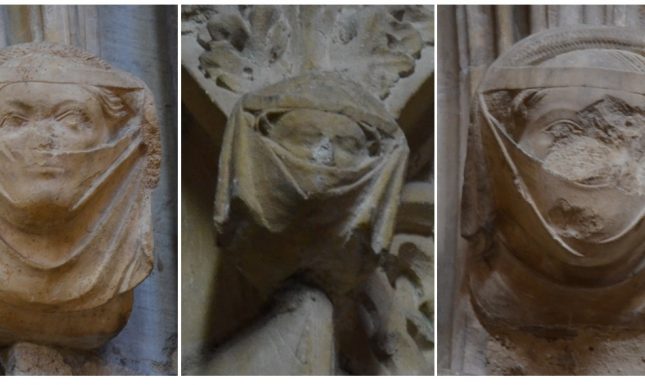

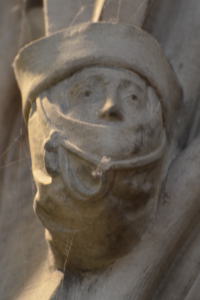
When a man has his mouth covered, as on a label stop in the York Minster chapterhouse, there is nothing puzzling about the image, especially as he is also wearing a thick cap. It seems he is shielding himself against the cold and has covered his mouth so as not to breathe in the cold air. When, however, as in Lincoln cathedral, one finds various sculptures of the late thirteenth and early fourteenth centuries with a finely attired woman wearing a cloth covering her mouth, one does wonder what the image is meant to convey. Covering one’s mouth with textile is unpleasant, as it prevents a person from breathing normally. Are these women that have been silenced, or does the image imply something else?
The face-covering cloth is in fact a ‘barbe’, a piece of material that normally covered both the breast and neck areas, and the chin. ‘Barbes’ were mainly worn in times of mourning, or by nuns and elderly women, as a symbol of one ‘s modesty, faithfulness, good behaviour and prudence, as is apparent from Chaucer’s Troilus and Criseyde, in which Criseyde’s uncle Pandarus visits his niece in order to persuade her to marry Troilus, and during his visit he asks her to remove her ‘barbe’, a garment symbolic of her widowhood, and to start having some fun again:
“Do wey youre barbe, and shew youre face bare; Do wey your, rys up, and lat us daunce,/ And lat us don to May som obervaunce”. Criseyde is not persuaded and replies: “I. God forbede! Be ye mad? / Is that a widewes lif, so God you save?”, and continues: “Lat maydens gon to daunce, and yonge wyves”. Pandaru, however, continues to pester Criseyde, and urges here as follows: “I say, aristh, lat us daunce,/ And cast youre widewes habit to mischaunce!/ What list yow thus youreself to disfigure./ Sith you is tid thus fair an aventure?”
Interesting is the passage where he states that the ‘barbe’ disfigures her face. Clearly, the garment was considered most unattractive. From other sources we can gauge that the way the ‘barbe’ was worn, was status-connected. In the mourning ordonnances that Margaret Beaufort, mother of King Henry VII had drawn up around 1502 it is said that “everie one not being under the Degree of a Baronesse to weare a Barbe above the Chinne. And all other as Knights wives, to weare it under their throats, and other gentlewomen beneath the throate goyle [Adamsapple]”.
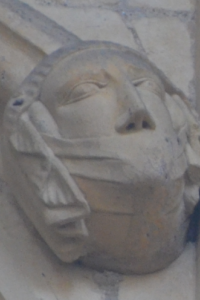
This having been said, wearing the ‘barbe’ over the mouth is unusual, albeit not unique. Similar mouth coverings feature on the misericords of the choir stalls of Winchester Cathedral; in the chapterhouse of York Minster; on a stone pulpit in Southwell Minster as well as in the passage connecting the Southwelll chapterhouse with the church proper; and on a label stop in Beverley Minster. Further examples occur in the parish churches of East Redford (Nottinghamshire), Oundle (Northamptonshire), Claypole (Lincolnshire), Heydour (Lincolnshire) en Patrington (Yorkshire). Maybe it denoted an extreme form of mourning, making it quite clear to the beholder that the lady in question had no plans of tying the knot once again and had in fact taken a widow’s vows. Such vows were taken publicly by women who then led a semi-monastic life, even though they lived in their own houses and did not follow any specific monastic rule. In Jacques Legrand’s Book of Good Maners, published in 1487, widowhood is defined as follows: “wedowhede is the state the whiche suceedeth to maryage and ought to be mayntened in grete humylyte. In grete deuocion. In simple habyte. In pylgremages. And other good dedes / For in wedowhede ought the vanyties of the world to be renounced”. This humility and devotion could well have been expressed by wearing the ‘barbe’ as a mouth covering. This rings true the more as in the later middle ages, especially in Germany and the eastern European countries, women also wore mouth coverings, which were known as ‘Mummel’, ‘Leidbinden’ or ‘Klagbinden’. Probably the best-known ‘Mummel’ wearer is Katharina of Bora, Martin Luther’s widow, of whom prints were made showing her in her widow’s attire: ‘D. Martini Luthers nachgelassene Witfrawn/in ihre Traurung’. She is dressed in a long black cloak, with a prayer book in her hand and her mouth covered by ‘Klagbinden’, which identified Katharina as a respectable widow.
It is clear then that this type of mouth coverings was worn precisely with the purpose of making a woman look unattractive, to denote they were not available and to keep those interested at bay.
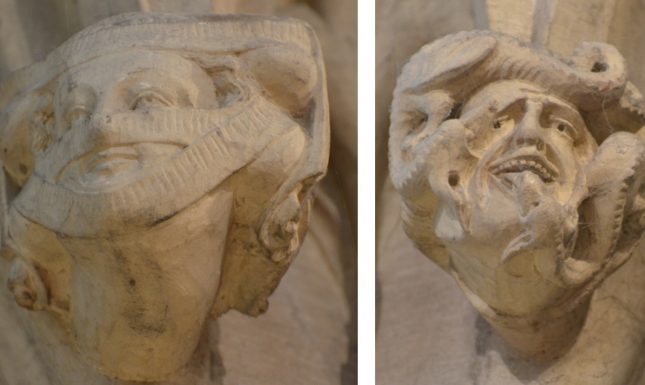

This having been said, the sculptural in England’s medieval churches produced examples of facial coverings that are even more unattractive and certainly less distinguished than the widow’s ‘barbe’. One of the label stops of the chapter house of York Minster is decorated with the head of a lady, who is looking quite pleased with herself, wearing the weirdest sort of contraption around her mouth. In addition to the ‘barbette’ (a band that holds the cap in place) covering her chin another strip of textile runs right across her face covering her nose. The mouth, however, is left free. It is difficult to find an explanation for this. Did women really wear stuff like that? Or is this a skit on contemporary fashions? The latter idea may have some validity as the label stop on her right shows a male head being besieged by small dragons who are slithering in and out of his mouth.
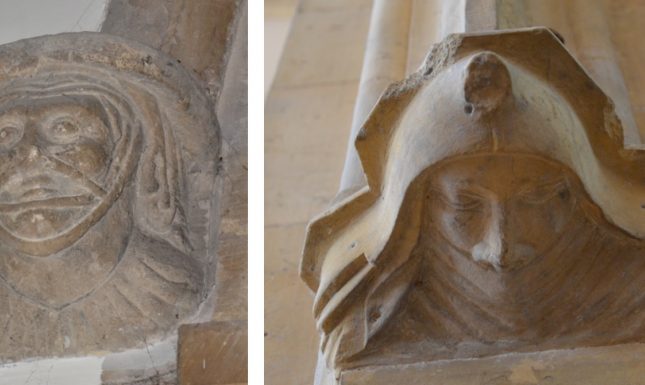

Similar, but not quite the same, is the facial attire of a woman on a corbel to the left of the portal leading into the nave of the church of St. Botolph’s in Saxilby-within-Ingleby. She is wearing a cap that leaves the oval of the face free but with a strange sort of triangular frame around her mouth. Was this ever a medieval fashion? Or is it a warning for the women entering the church to keep their mouths shut, with the triangle acting as a marker of danger?
Another odd example features as a corbel on the south side of the nave of Beverley Minster. Here we cannot even determine whether it a is a man or a woman. There is something ominous about the figure. Covered with a hood also, this person looks like an assassin from out of the shadows.
As today’s facial masks, medieval face coverings are odd and disconcerting. People wore them to keep out the cold, to keep admirers at bay, to show how good and well-behaved they were and how strictly they conformed to the rules laid down by society. The reasons for wearing facial masks were not much different from the ones today. However, one must concur with Chaucer that the face mask alienates a person from others. That seeing a person wearing one is disconcerting, is a feeling of all times.
© Elizabeth den Hartog and Leiden Medievalists Blog, 2020. Unauthorised use and/or duplication of this material without express and written permission from this site’s author and/or owner is strictly prohibited. Excerpts and links may be used, provided that full and clear credit is given to Elizabeth den Hartog and Leiden Medievalists Blog with appropriate and specific direction to the original content.


